Hasya Kavi Sammelan 2017
Posted by admin in October 2017, Past issues on October 7, 2017
By Jayashree Phanse, Mars, PA Â Â Â Â Â Â Â Â Â Â Â Â e-mail: Â Â jsphanse360@gmail.com
On 21 April, the Antar Rashtriya Hindi Samiti (International Hindi Association, or IHA) organized a Kavi Sammelan (impromptu poetry recital) at the SV Temple auditorium. The evening was three continuous hours of humorous, satire-filled nonstop poetical repartee. The large attendance at the program was a testimony to the program’s success. The IHA, a nonprofit organization, strives to preserve and promote the linguistic tradition and interests related to Hindi on a global scale to highlight human values inherent in its literature.
It is difficult to translate satire and humor in any language into other languages having different idioms, grammar, rhyming schemes and literary traditions. So, I can not bring out the nuances of the evening.
The three poets who enlivened the evening were Gajendra Solanki, Sudeep Bhola and Sunil Jogi.
Shri Gajendra Solanki started the evening with an ode to India, to its culture, to its temples, to Mahatma Gandhi, to Hindi the national language. In the ocean of languages, he claimed Hindi, the daughter of Sanskrit, was the nectar. Solanki in his melodious voice presented with satire the issue with demonetization, and needled politicians. With hilarious, elevating, clap-generating quips, he presented to the Desis living all over the world, declaring them Karma Yogis in the true sense.
The young and talented Sudeep Bhola’s political satire and single liners were biting. With his charismatic poetic performance, he made the audience laugh and cry. He took us on a journey of emotions from satire and humor, to sacrifices by patriotic martyrs, to thought-provoking social issues on Indian women and children.
Dr. Sunil Jogi, a Padma Shri award recipient, the chairman of the Hindustan Academy, and a Minister of State in the Government of Uttar Pradesh came next. Proceeds of his tours always fund his nonprofit organization promoting sustainable education in rural areas. One of his presentations touched me: “God requests His devotee to visit Him not in temple but in the hut of the old woman in the slum and feed her the Prasad. I am with the children washing plates in the restaurants near your house. With the money for the hundi please buy books for them to go to school.â€
Sanjeev Sharma, IHA secretary gave the welcome and the vote of thanks. Ananya Jadia, Ananya Tripathi and Mallika Acharcya from
Vidya Mandir and Chinmaya Mission introduced the poets in Hindi. years ahead, you should strive for perfection. That will ensure you will be the best you can be.    ♣
Home
Sia Iyer’s Impressive Karnatic Vocal Arangetram
Posted by admin in October 2017, Past issues on October 7, 2017
By Sujana Mulukutla, Wexford, PA Â Â Â Â e-mail: Â sujana_m@hotmail.com
Sia Iyer, a rising 7th grader, had her vocal Karnatic arangetram at Upper St Clair High School on July 8th, 2017. All of twelve years of age with a tiny presence on stage, but what a presence it was! She displayed her mastery over sruti, ragam, talam and kaala-pramanam and kept her audience spell-bound for a good two-and-a-half hours.
Just as a diamond needs to be polished and chiseled to radiate its shine and luster, so too Sia is lucky to have her guru, Smt. Vijayalakshmy Subrahmaniam (Chennai), who worked tirelessly to bring out Sia’s best.
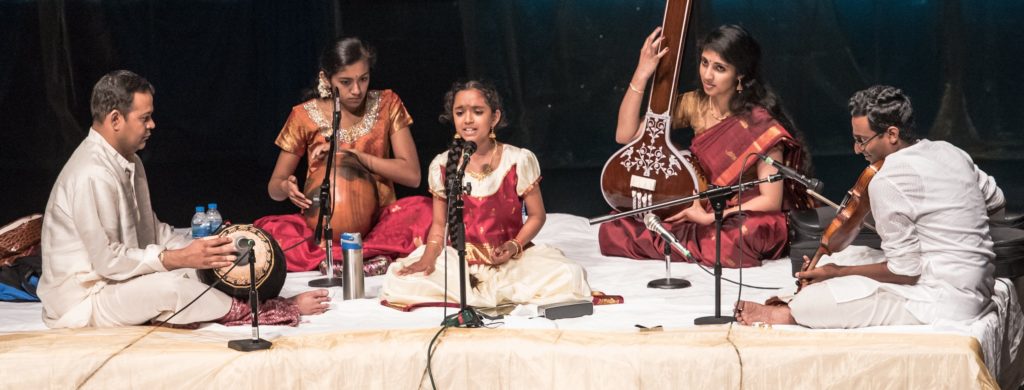 Sia opened with the challenging Ata Tala Varnam in Todi and rendered it well. The majestic Vallabha in Begada followed with crisp sangatis and kalpana swarams executed with ease. A short raga alapana in Malayamarutam with lovely sancharas was followed by Dhanyudevvado, a Patnam Subramanya Iyer’s krti. Sia then took on Janani Ninnuvina, which she delivered with finesse. Sia then elaborated a detailed Kambhoji raagam (Evari Mata) with the hallmark sangatis of her guru.
Sia opened with the challenging Ata Tala Varnam in Todi and rendered it well. The majestic Vallabha in Begada followed with crisp sangatis and kalpana swarams executed with ease. A short raga alapana in Malayamarutam with lovely sancharas was followed by Dhanyudevvado, a Patnam Subramanya Iyer’s krti. Sia then took on Janani Ninnuvina, which she delivered with finesse. Sia then elaborated a detailed Kambhoji raagam (Evari Mata) with the hallmark sangatis of her guru.
A short and sweet Ragam-Taanam-Pallavi in Ranjani followed, which Sia topped off with smooth and seamless transitions into Janaranjani, Sriranjani, and Shivaranjani. The Abhang, Sakha mazha moved many members in the audience to tears with Sia’s soulful rendition. Sia concluded the concert with a melodious but challenging tillana in Sindhu Bhairavi.
Vidwan L. Ramakrishnan did an amazing job in executing silken strokes on the violin, while Vidwan Vinod Seetharaman excelled in mridangam accompaniment. Both gave the young Sia encouraging nods of approval. Samyukta Sreeram, a high-schooler, nicely complemented Vinod on the Ghatam. Pallavi Muluk was on the tambura.
Sia, you’re a young talent with great potential. Remember, this is just a beginning in your journey in music. In the years ahead, you should strive for perfection. That will ensure you will be the best you can be.
Home
A Delightful Violin Arangetram
Posted by admin in October 2017, Past issues on October 7, 2017
By Shankar Krish, Wexford, PA         e-mail:   shankar.krish@gmail.com
Shankar Krish has learned Karnatic music on the violin and is a familiar face among Indian classical music lovers in our area.
I had the pleasure of attending the arangetram of Saarang Mulukutla on the violin in July 2017. With Sumesh Narayanan on mrdangam and Ravi Balasubramanian on ghatam, it was a melodious, engaging and enjoyable debut solo recital.
As a student of well-known violinist L Ramakrishnan (who is a disciple of the veteran violinist A Kanyakumari), Saarang has absorbed the style of playing the instrument as well as rendering the compositions with equal emphasis on the lyrics and melody. Starting with the varnam, and through the many compositions, the tillana and mangalam, Saarang exhibited maturity and consistency on the violin.
The highlight of the concert was his detailed alapana in raga bhairavi, a complex raga with unique phrases and characteristics. He rendered it quite well considering that this was his maiden concert. He brought out the highlights of bhairavi in the alapana and the composition ‘upachAramu jesEvAru’ to the best of his abilities.
Sumesh and Ravi, the professional percussion duo, provided supportive rhythm accompaniments throughout the recital, encouraging Saarang all through. They played a fantastic tani avartanam (percussion solo) showcasing their expertise of their instruments.
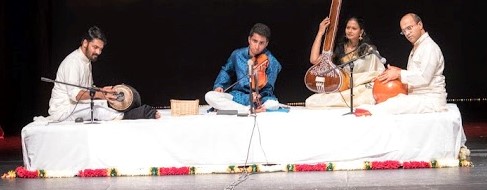
I had heard his guru Sri L. Ramakrishnan, a great teacher, just a week earlier. So, I could see that Saarang has absorbed the teachings and style of his guru. That Ramakrishnan taught Saarang mostly through online classes tells a lot of the dedication of both the teacher and the taught.
Growing up in a family steeped in music, Saarang has clearly taken advantage of the environment at home and support from his family. With his hard work that I have personally observed, Saarang has blossomed into an excellent musician. Arangetram is only the first step, and I expect he will continue to improve on his skills, repertoire and the nuances of the Indian classical music tradition.
At the end of the concert, Kumari A Kanyakumari, the chief guest of the evening, blessed Saarang on his maiden performance and offered words of encouragement. Saarang will certainly cherish the presence and blessings of the veteran A Kanyakumari that are bound to motivate him to set higher goals in his musical journey.   ♣
Home
The Palanisamys’ Adieu to the ‘Burgh
Posted by admin in Past issues on October 7, 2017
By Ray Kathiresan, Pittsburgh, PA Â Â Â Â Â Â Â Â Â Â Â Â Â Â Â Â Â e-mail:Â raykathiresan@yahoo.com
On Ju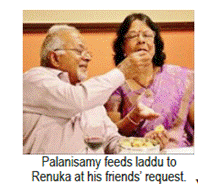 ne 10,2017 friends of Dr. Palanisamy (Samy) and his wife Renuka were at Tamarind Restaurant in Greentree to have a good time. The occasion: The Samys were bidding Adieu to their 30-plus years in Pittsburgh and their friends in a Taking Leave Party they hosted. Dr. Samy had a productive career as a cardiac surgeon for over 30 years and an active social life with a large circle of friends.
ne 10,2017 friends of Dr. Palanisamy (Samy) and his wife Renuka were at Tamarind Restaurant in Greentree to have a good time. The occasion: The Samys were bidding Adieu to their 30-plus years in Pittsburgh and their friends in a Taking Leave Party they hosted. Dr. Samy had a productive career as a cardiac surgeon for over 30 years and an active social life with a large circle of friends.
After temporarily moving to Florida after retirement, the Samys shuttled between their home in Florida and Pittsburgh for several years. Then, they decided to permanently move to Ft. Lauderdale. So, the evening of the taking leave party was full of nostalgia, mirth, laughter, with roasts, music, and of course, good food.
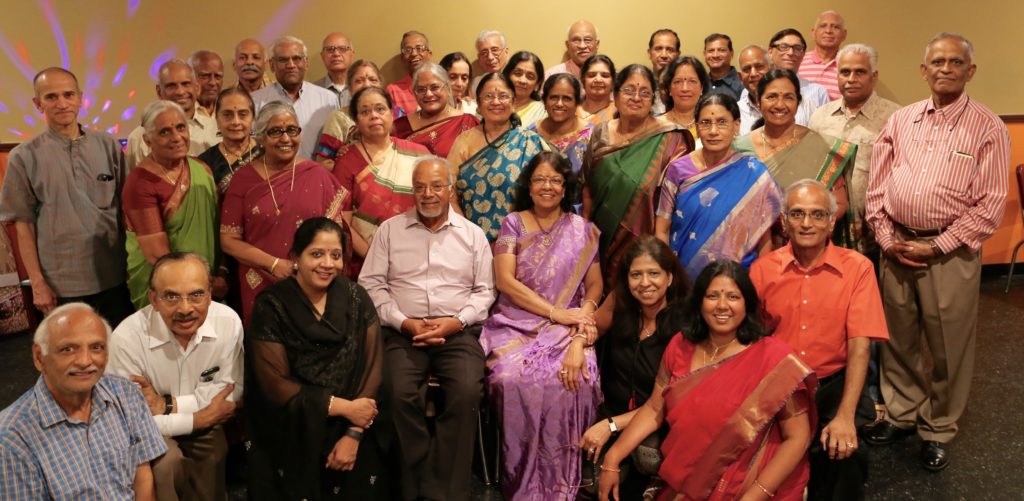 Dr. Samy earned his MBBS degree from Stanley Medical College in Chennai. He had his thoracic surgery practice in Dubuque, Iowa for 10 years, and then in Pittsburgh, PA for over 30 years. As the chairman of the Tamil Nadu Foundation, he organized two national conferences of the Foundation in Pittsburgh. Their son Sridhar and daughter-in-law Laxmi live in Chicago. The Samys love their twin grand kids, Sia and Shyla.
Dr. Samy earned his MBBS degree from Stanley Medical College in Chennai. He had his thoracic surgery practice in Dubuque, Iowa for 10 years, and then in Pittsburgh, PA for over 30 years. As the chairman of the Tamil Nadu Foundation, he organized two national conferences of the Foundation in Pittsburgh. Their son Sridhar and daughter-in-law Laxmi live in Chicago. The Samys love their twin grand kids, Sia and Shyla.
Both Samy and Renuka love charity and social services. Their friends in Pittsburgh wish Samy the best golfing in Florida, and an ever-expanding circle of friends for Renuka not only in Ft. Lauderdale, but all across Florida as well. (Graphics courtesy of R. Venkataramanan)   ♣ Â
Home
US Chief Justice John Roberts’ Commencement Address to 9th Graders — Could as Well Be for Our Young Adults Today
Posted by admin in October 2017, Past issues on October 7, 2017
In July of this year, US Supreme Court Chief Justice John Roberts gave a very unusual commencement speech at the Cardigan Mountain School, a private boys-only boarding and day school in New Hampshire, from which his son was graduating. He told the graduating youngsters what can happen if we do not learn the correct lessons growing up, especially if you are born to privilege. Here are some excerpts from his address:
“Rain, somebody said , is like confetti from heaven. So even the heavens are celebrating this morning, joining the rest of us at this wonderful commencement ceremony. … …
, is like confetti from heaven. So even the heavens are celebrating this morning, joining the rest of us at this wonderful commencement ceremony. … …
“… If you look back to your first afternoon here at Cardigan, perhaps you will recall that you were lonely. Perhaps you will recall that you were a little scared, a little anxious. And now look at you. You are surrounded by friends that you call brothers, and you are confident in facing the next step in your education…. … And as far as the confidence goes… … it is not because you succeeded at everything you did, but because with the help of your friends, you were not afraid to fail. And if you did fail, you got up and tried again. And if you failed again, you got up and tried again. And if you failed again, it might be time to think about doing something else. But it was not just success, but not being afraid to fail that brought you to this point.
“Now commencement speakers will typically also wish you good luck… I will not do that, and I’ll tell you why. From time to time in the years to come, I hope you will be treated unfairly, so that you will come to know the value of justice. I hope that you will suffer betrayal because that will teach you the importance of loyalty. Sorry to say, but I hope you will be lonely from time to time so that you don’t take friends for granted.
“I wish you bad luck, again, from time to time so that you will be conscious of the role of chance in life and understand that your success is not completely deserved and that the failure of others is not completely deserved either. And when you lose, as you will from time to time, I hope every now and then, your opponent will gloat over your failure. It is a way for you to understand the importance of sportsmanship. I hope you’ll be ignored so you know the importance of listening to others, and I hope you will have just enough pain to learn compassion.
“Whether I wish these things or not, they’re going to happen. And whether you benefit from them or not will depend upon your ability to see the message in your misfortunes.
“Now commencement speakers are also expected to give some advice. They give grand advice, and they give some useful tips. The most common grand advice they give is for you to be yourself. It is an odd piece of advice to give people dressed identically… But you should understand what that means. Unless you are perfect, it does not mean don’t make any changes. In a certain sense, you should not be yourself. You should try to become something better. People say ‘be yourself’ because they want you to resist the impulse to conform to what others want you to be…. …
“Now some tips as you get ready to go to your new school. Over the last couple of years, I have gotten to know many of you young men pretty well, and I know you are good guys. But you are also privileged young men. And if you weren’t privileged when you came here, you are privileged now because you have been here. My advice is: Don’t act like it.
“When you get to your new school, walk up and introduce yourself to the person who is raking the leaves, shoveling the snow or emptying the trash. Learn their name and call them by their name during your time at the school. Another piece of advice: When you pass by people you don’t recognize on the walks, smile, look them in the eye and say hello. The worst thing that will happen is that you will become known as the young man who smiles and says hello, and that is not a bad thing to start with…â€
Mr. Roberts concluded his address by reciting the poem Forever Young by Bob Dylon. As I was reading the commencement speech, I recalled the following colloquial Tamil proverb:
 Translation: “Even your Annan (older brother) and Tambi (younger brother) are not as helpful [to grow] as the ‘beatings’ you get [in life].†The “beatings†are the humiliations, failures, disappointments, and betrayals — even bad luck in life that the chief justice talked about in addressing his young audience. Well-educated Millennials (Desis included), many of them born to comfort bordering privilege, now are working trying to climb their career ladders. They too will benefit if they heed Justice Roberts’ speech. Given the recklessness emanating from the occupants of the West Wing offices of the White House today, I wonder whom the learned Chief Justice had in mind in his commencement address.
Translation: “Even your Annan (older brother) and Tambi (younger brother) are not as helpful [to grow] as the ‘beatings’ you get [in life].†The “beatings†are the humiliations, failures, disappointments, and betrayals — even bad luck in life that the chief justice talked about in addressing his young audience. Well-educated Millennials (Desis included), many of them born to comfort bordering privilege, now are working trying to climb their career ladders. They too will benefit if they heed Justice Roberts’ speech. Given the recklessness emanating from the occupants of the West Wing offices of the White House today, I wonder whom the learned Chief Justice had in mind in his commencement address.
— By K S Venkataraman Â
The author acknowledges Arun Jatkar for sending a shorter video clip of the speech, which led him to get the transcript of the entire speech. ♣
Home
Community Profile — Som Sharma
Posted by admin in October 2017, Past issues on October 7, 2017
By Arun Jatkar, Monroeville, PA Â Â Â Â Â Â Â Â e-mail: Â ajmarathi@yahoo.com
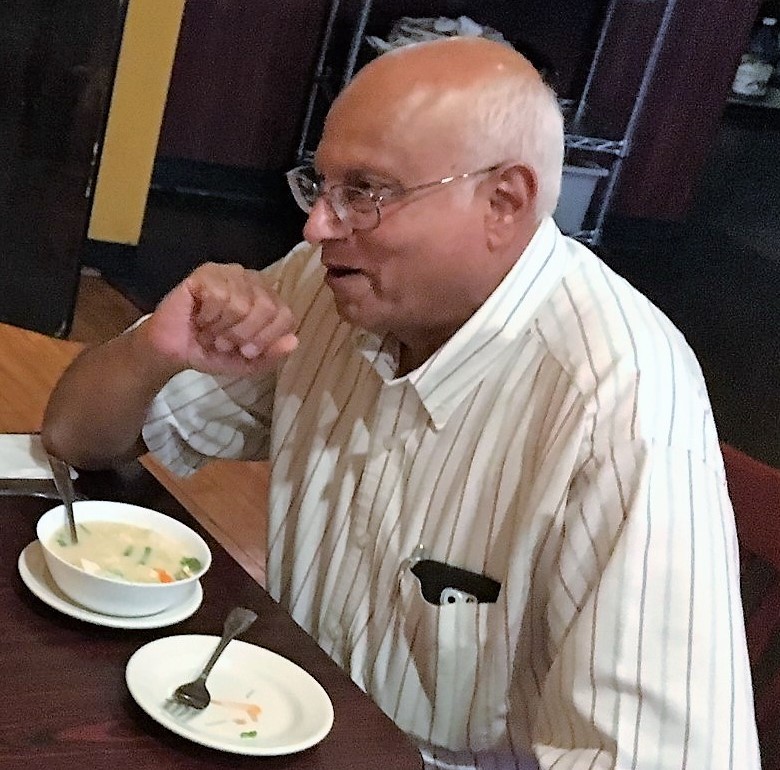 Som Sharma, now retired after a three-decade long career as a financial planner, has presented and represented India and Hinduism in many forums for many years well before l ocal temples and other organizations got into the act. Recently Arun Jatkar (picture on the left), another long-time resident here, talked to Som Sharma (left in the picture below) about this journey. Arun talked to Som on various topics over dinner at Green Mango, a Thai restaurant in Wilkins Twp. Arun, an engineer-researcher by profession, has worked in various capacities in many industries. Both are now active on other fronts. Since 2001 Arun has been the editor of Ekata, the first Marathi quarterly magazine of North America published from Toronto, Canada since 1978. Som has been organizing the Gandhi Jayanti (birthday) (October 2) in fall for the last fifteen years. — Editor
Som Sharma, now retired after a three-decade long career as a financial planner, has presented and represented India and Hinduism in many forums for many years well before l ocal temples and other organizations got into the act. Recently Arun Jatkar (picture on the left), another long-time resident here, talked to Som Sharma (left in the picture below) about this journey. Arun talked to Som on various topics over dinner at Green Mango, a Thai restaurant in Wilkins Twp. Arun, an engineer-researcher by profession, has worked in various capacities in many industries. Both are now active on other fronts. Since 2001 Arun has been the editor of Ekata, the first Marathi quarterly magazine of North America published from Toronto, Canada since 1978. Som has been organizing the Gandhi Jayanti (birthday) (October 2) in fall for the last fifteen years. — Editor
Long-time residents of the Greater Pittsburgh Metro area know Mr. Som Sharma of Monroeville through at least one of the myriad endeavors (apart from his profession as a financial planner), of which Sharma is, or has been, the vital force and the prime mover. I was delighted to talk to him at the Green Mango Thai restaurant on Business 22. The primary intent was to learn more about Sharma’s association with the Monroeville Interfaith Ministerium, a group of representatives from different faiths, including Catholics, mainstream Protestants, Jews, Muslims, Sikhs, Buddhists, Jains, and Hindus.
 Interfaith dialogue is important in any society where people of many different faiths have to live and work together. In the US, in the early days, there were only the various denominations within Christianity to begin with. Jews arrived later. Many Americans until recently, were not even aware of other faiths such as Hindu, Moslem, Zoroastrian, Buddhist, Jain, Sikh, and Baha’I.
Interfaith dialogue is important in any society where people of many different faiths have to live and work together. In the US, in the early days, there were only the various denominations within Christianity to begin with. Jews arrived later. Many Americans until recently, were not even aware of other faiths such as Hindu, Moslem, Zoroastrian, Buddhist, Jain, Sikh, and Baha’I.
Som explained that in the early 1980s his wife Vandana volunteered as the director of the Indian community’s dance groups participating in the Pittsburgh Folk Festival and he helped in her organizational effort. This led to contacts with several ethnic communities in and around Pittsburgh and invitations from local churches to speak about the Hindu religion.
This was one of the reasons why Som got involved in the interfaith dialogue, as a member of Monroeville Interfaith Ministerium. Ministerium is an association of clergy from various religious groups coming together to accomplish a specific purpose, often to build collegiality and address socioeconomic needs in the community. The clergy represented churches, synagogues, temples, mosques, and other congregations that are often connected geographically in a small town or group of small towns.
The Archdiocese of Chicago’s Office for Ecumenical and Interreligious Affairs differentiates between ecumenical, interfaith, and interreligious relations. But for most people “Interreligious†is synonymous with “Interfaith.â€
Som said, “The 1893 Parliament of World Religions in Chicago is often regarded as the birth of the ‘Interfaith Movement.’ This congress was the first organized international gathering of religious leaders.â€Â Swami Vivekananda spoke at this congress over 120 years ago. However, it seems to this writer that Indian communities all over the US are slow to see the merit of participating in local interfaith organizations.
Som Sharma’s example was followed by Vinod Doshi (from the H-J Temple) representing the Jains, and Gurdayal Singh Mehta (Monroeville Gurudwara) representing the Sikhs.
The seed sown by Som has grown into the Hindu-Jain Temple of Monroeville now becoming a member of the Monroeville Interfaith Ministerium, wherein Harilal Patel and Damayant Agarwal represent the Hindu-Jain Temple Pariwar. During Thanksgiving, the member organizations within the Ministerium take turns gathering at one of the participants’ place of worship to share a simple meal to bring people of all faiths together.
After the ghastly 9/11 attack in 2001 on the World Trade Center in New York, interfaith dialogue became a necessity all across the US. Som has eloquently represented the Hindu faith at many of these gatherings, some of them held in open play grounds.
Given the recent events in Charlottesville, NC (and earlier events of hate crimes committed against innocent Indians in Pittsburgh), one sees the need for the interfaith dialogue to keep going from strength to greater strength, for which Som sowed the seeds over three decades ago.
The ultimate goal of the Indian community ought to be to cultivate an environment of interfaith amity and understanding in the US, wherein all faiths will regard each other with mutual respect, going beyond the stock expression of tolerance, commonly used in Interfaith interactions.  ♣
Home
Volunteers Fill School Bags with Supplies and Donate to Homeless Kids
Posted by admin in October 2017, Past issues on October 7, 2017
By K S Venkataraman          e-mail:  thepatrika@aol.com
 Volunteers from the Wold Hindu Council took the initiative for a noble cause. They pooled volunteers to organize filling school bags with supplies for students going to school in the Fall. These bags go to homeless school children in our area—by far the most needy and deserving students among us for this kind of assistance.
Volunteers from the Wold Hindu Council took the initiative for a noble cause. They pooled volunteers to organize filling school bags with supplies for students going to school in the Fall. These bags go to homeless school children in our area—by far the most needy and deserving students among us for this kind of assistance.
The Monroeville India Garden Restau rant’s Shinghara Singh and his wife Davinder Singh offered their banquet hall for free to the volunteers for this group effort, and also fed the volunteers for free!
rant’s Shinghara Singh and his wife Davinder Singh offered their banquet hall for free to the volunteers for this group effort, and also fed the volunteers for free!
Over 125 backpacks were filled and handed over to the local chapter of the Homeless Children’s Education School Supplies Drive. Volunteers from the Maharashtra Mandal, H-J Temple’s Vidya Mandir and many individuals gave their time in this noble cause. The SV Temple donated $500. The picture above shows the bags being filled, and the one below are the volunteers who made this possible.   ♣
Home
New Nonstop Flights to Europe Inaugurated
Posted by admin in October 2017, Past issues on October 7, 2017
By Premlata Venkataraman       e-mail:  thepatrika@aol.com
On June 23rd Pittsburgh International Airport, after a thirteen year hiatus, got its first nonstop flight to Frankfurt with Condor Airlines’ twice-a-week flight. As Pittsburgh slowly shores up its international image, a nonstop flight to Frankfurt will  greatly enhance this effort. The flight is seasonal, through September, and only twice a week — on Mondays and Fridays. Given how difficult it is to get nonstop flights to European destinations from second-tier cities in the US, this is a good start.
greatly enhance this effort. The flight is seasonal, through September, and only twice a week — on Mondays and Fridays. Given how difficult it is to get nonstop flights to European destinations from second-tier cities in the US, this is a good start.
On the maiden flight were Rich Fitzgerald, the chief executive of Allegheny County, Christina Cassotis, CEO of Allegheny County Airport Authority, and other airport officials.
Earlier in mid-June, Iceland’s low-cost WOW Airlines started its all-year round, 4-times a week non-stop flights to Reykjavik from Pittsburgh. Coming on its heels, Condor’s twice-a-week seasonal flight will make travel to Europe convenient.
On the day Condor’s maiden flight landed, we had a close-up view of the landing while standing on the taxiway close to the end of the runway. Water cannons welcomed the plane at the gate. See picture.
 A welcome ceremony was set up near the baggage claim area. Mr. Fitzgerald and other officials spoke. German favorites — pretzels, bratwurst and other snacks were laid out, and a celebratory cake was cut to the accompaniment of German music.
A welcome ceremony was set up near the baggage claim area. Mr. Fitzgerald and other officials spoke. German favorites — pretzels, bratwurst and other snacks were laid out, and a celebratory cake was cut to the accompaniment of German music.
“Additional service to Europe has been a top priority for Pittsburgh International Airport. The airline’s wide-body aircraft is a great addition for Europe-bound travelers from Pittsburgh,†said Cassotis in her remarks.
Pittsburgh International valiantly tries to c orrect the reverses suffered by US Airways shutting down its PIT hub. Obviously, the new nonstops to overseas destinations are possible only with financial concessions to both Condor and WOW. Hopefully, with these steps, we will see better days.
orrect the reverses suffered by US Airways shutting down its PIT hub. Obviously, the new nonstops to overseas destinations are possible only with financial concessions to both Condor and WOW. Hopefully, with these steps, we will see better days.
End Note: For passengers from our area to destinations in the Middle East, the Indian subcontinent, and Africa, the best option is a nonstop from Pittsburgh to Dubai or Abu Dhabi. This is because there are several daily non-stops from Persian Gulf hubs to cities in Africa and the Indian subcontinent. Our hope is for Pittsburgh to get a nonstop flight to Dubai, Abu Dhabi, or Qatar. Let us hope it is soon!   ♣
Home
VegFest 2017 — A Big Hit in the ‘Burgh
Posted by admin in October 2017, Past issues on October 7, 2017
By Premlata Venkataraman       e-mail:  thepatrika@aol.com
Even for the nonvegetarians among us, delicious all-vegetable dishes are a big part of our cuisine. Yet, how many of us know that we have an annual vegan food festival, VegFest, right here, in the ‘Burgh, every summer?
The third annual Veg Fest was held Saturday, August 6 at the Allegheny Commons Park East, close to Allegheny General Hospital. The balmy weather with a brisk wind attracted over 10,000 people — seniors, young parents with kids, and youngsters, lazing around the many stalls.
Fest was held Saturday, August 6 at the Allegheny Commons Park East, close to Allegheny General Hospital. The balmy weather with a brisk wind attracted over 10,000 people — seniors, young parents with kids, and youngsters, lazing around the many stalls.
Every cuisine was represented. In addition to Chinese, Thai, Mediterranean, and Indian food, people could taste vegetarian snacks from Mexico, the Caribbean, many parts of Europe — even grilles and chilies. When we went there around 2:00 PM (the closing time was 7:00 PM), many stalls had already run out of food — that is how popular the event was.
In addition, there were stalls on cosmetics displaying items that had no animal content in them, and that did not use animals in testing.
 The prime movers behind VegFest are Leila Sleiman (right) and Natalie Fristick (left) in the picture on the right. They became friends while participating in a protest against animal cruelty in circuses. Their organization Justice for Animals (JFA), extends compassion to more than just dogs and cats.
The prime movers behind VegFest are Leila Sleiman (right) and Natalie Fristick (left) in the picture on the right. They became friends while participating in a protest against animal cruelty in circuses. Their organization Justice for Animals (JFA), extends compassion to more than just dogs and cats.
Leila has participated in other VegFest events across the US. Three years ago, they saw the potential for an outdoor VegFest in summer in Pittsburgh to highlight the issues in a family friendly and positive way.
The sponsors for this year’s festival were: Whole Foods, Smoothy King, East End Food CoOp, WESA-FM 90.5 (Pittsburgh’s NPR news station), and Pittsburgh Port Authority, among others.
With grape leaves, tabbouleh and hummus, and a slice of baklava for dessert we settled down for an alfresco lunch, listening to live music. A fun way to spend a summer afternoon for this vegetarian couple!  ♣
Home
Globalization — NOT Something New
Posted by admin in October 2017, Past issues on October 7, 2017
By Kollengode S Venkataraman      e-mail:  thepatrika@aol.com
People talk on globalization today as if it is something new. But this has been going on for over at least 2,500 years. Before the Industrial Revolution (1760 to 1840 Common Era) triggered by the steam engine and spinning jenny in Europe, over 50% of the world GDP of those times was split between India and China for over 2,000 years. See the bar chart below (Source: The Economist). With so much of the world’s goods produced in these two Asian geographic regions, the bulk of the global trade of those times was between these two regions and Southern European 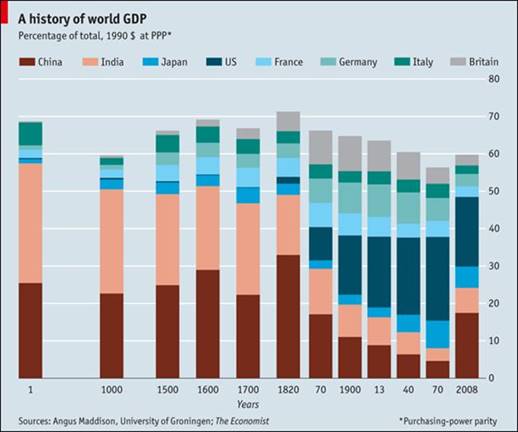 empires and the region between them—mainly Arabia, Persia, the Persian Gulf, and Central Asia. Northern and Western Europeans — today’s Advanced Societies — were living either on trees or under tree shades, or in caves. Many trade routes at the dawn of the Common Era are available on the Web. A typical one is shown further below.
empires and the region between them—mainly Arabia, Persia, the Persian Gulf, and Central Asia. Northern and Western Europeans — today’s Advanced Societies — were living either on trees or under tree shades, or in caves. Many trade routes at the dawn of the Common Era are available on the Web. A typical one is shown further below.
Global trade before the Industrial Revolution was peaceful, relatively speaking in any case, excepting for infrequent highway robberies and piracies along the routes affecting only the traders.
 However, global trade after the Industrial Revolution impacted the world in ways unimaginable before, leading to the complete destruction of native industries. The classic example is what Britain’s East India Company in India did to its sophisticated textile industries. Using foul means, the Company destroyed the sophisticated, traditional Indian textile industries in which thousands of families had been engaged for generations. Then it made the native population depend on textiles imported from England. The gory details are well documented.
However, global trade after the Industrial Revolution impacted the world in ways unimaginable before, leading to the complete destruction of native industries. The classic example is what Britain’s East India Company in India did to its sophisticated textile industries. Using foul means, the Company destroyed the sophisticated, traditional Indian textile industries in which thousands of families had been engaged for generations. Then it made the native population depend on textiles imported from England. The gory details are well documented.
Nobody knows who coined the word “globalization.†The Oxford Dictionary says the word “globalization†was first employed in 1930. What one means by “globalization†depends on who defines it:
Merriam Webster: the process of globalizing; the state of being globalized; … the development of an … integrated global economy marked… by free trade, free flow of capital, and the tapping of cheaper foreign labor markets.
Business Dictionary: The worldwide movement toward economic, financial, trade, and communications integration.
SUNY Levin Institute: Globalization is a process of interaction and integration among the people, companies, and governments of different nations. It is driven by international trade and investment, aided by information technology. This process affects the environment, culture, political systems, economic development, prosperity; and Mankind’s well-being… around the world.
Here are India’s ideas of a global village: Puranaanooru, an ancient Tamil literary work dated around 1st century of the Common Era, declares: “yaadum ooray, yaavarum keLir,â€Â literally, “Every village is my native hamlet, and all are my kinsmen.†An Upanishadic phrase echoes similarly: vasudhaiva kutumbakam, or “The whole world is, indeed, a family.â€
The industrial powers of the world, mostly European, for nearly 250 years after the Industrial Revolution, mastered mass manufacturing and international trade backed by Science and Technology (S&T). Concurrent developments in S&T helped these great powers to strengthen their armies, navies and later, air forces. With governments, industry, S&T, military, and trade mutually helping each other, European empires, controlled the world economically, politically, and militarily. Japan was the only Asian power in this context. India, in its early days after independence, was in the Soviet Camp for decades.
Decades before economists talked about integration of the world through trade, attempts were made to unite workers globally. In the 1960s, the common sloganeering among Indian Communists in rallies was, “Workers of the World, UNITE!â€Â Indian Communists, inspired by their patron saints, the Soviet Union and China, were fighting for Indians to have working conditions similar to those in Europe. But the Indian communists then were wary of internationalizing capital, production and trade; for all their “modern” outlook,  Indian communists were regressive and opposed modernization/computerization/automation. That is another story.
Soviet Union is now dead and China is only nominally Communist. But Indian Communists, like rare marooned species in far away islands from their native habitat, still survive as endangered species living in their ideological past, which China and Russia, their spiritual masters,  have abandoned decades ago. Now in India, an amalgam of Leftist Movements (communists, socialists and their fellow-travelers ensconced within the confines of the security the Indian Academia provides), is struggling to be socially and politically relevant. Discernible cracks are emerging within this amalgam.
Capitalists are no better:Â While capitalists and governments professing Free Market economy want free flow of capital and goods across borders, they do not want a free flow of workers across borders.
Also, globalization has been going on for long even in recent times, even though the term globalization was not attached to it.
- The US steel Industry was built on the backbreaking work of European immigrants, Mexicans and the nominally liberated Blacks. With a shortage of native workers, Germany’s economic miracle in the mid-20th century was possible only with Turkish “guest workers.â€
- Indian IT professionals flooding the US during the Y2K crisis at the turn of the millennium is well known. It changed the demographics of the US –Â and Indians’ self confidence in themselves –Â in a fundamental way.
- The healthcare industry in the US and the UK is sustained only with the large number of healthcare workers—mostly doctors and nurses — from the Indian subcontinent, the Philippines, and Africa.
- Your fruits/vegetables are inexpensive because migrant farm workers from Mexico and Central America toil in harsh conditions that Americans do not want to work under. Also, for a long time, produce items from Mexico and Central America have been staple in American supermarkets. Western Europe’s farming is sustained only by cheap labor from Poland, Rumania, and other Eastern European countries.
- In culturally diverse countries, such as India and China, rapid and mass migrations within the individual nation-states is a new phenomenon. It has now become more rapid, and not confined to the better educated and trading classes. In India, the less-educated muscular youth seeking livelihood are moving from poorly managed states to more prosperous regions. This has added a new dimension to India’s social complexity. .
- The luster of the United Arab Emirates, Saudi Arabia, and others is built with their petro-dollars. But they had to import technology from the West; and cheap skilled workers from the Indian subcontinent working under precarious conditions that Arab natives refused to work under.
The European trading companies, with help from their empires back home in France, England, Portugal, and Holland, ended up as colonizing/occupying powers, with Christian missionaries contributing to stir the pot. Read on the Goan Inquisition in India to know all the ghastly things unleashed by the missionaries in the Konkan region under the leadership of Francis Xavier (1502-1556), with help from Portugal’s king. Later, the Vatican canonized Xavier as a saint in 1622.
In the early days of the British East India Company (in the 18th century), Anglo-French wars were fought on Indian soil. With no stakes in the war between England and France in Europe, Indian soldiers in the armies of Robert Clive and Joseph Dupleix spilled their blood and died in the Anglo-French wars fought on Indian soil. Read on the Carnatic Wars in India (between 1744-1763) for details.
In the early 19th century, the British Empire had a huge trade deficit with China (China was a net exporter even then). To break this, England stealthily expanded its trade in China by exporting to China the opium made in India. This led to the Opium Wars (1839-60) that destroyed China’s ruling Qing dynasty, and made the Chinese populace opium addicts. The Chinese never forgot what the Europeans did to them.
The world has changed. The unbridled advantages the industrialized West had for over 250 years with their superior grasp of S&T, industrial power, military strength, and wealth have run its course. S&T is now accessible to any society willing to invest in them and work at it. China has already emerged as a global economic power, in manufacturing, trade, and military. China has captured their glorious past with a vengeance.
India is still emerging, but it may take another 30 years to regain its foothold. For this to happen the Indian middle class and its upper crust need to liberate themselves to look at India through their own lenses and not through the Europeans’ lenses. This is more easily said than done because the Indian upper crust today is completely uprooted from India’s languages and its literary, artistic and philosophical traditions. Even after seventy years since the British left India, Indian intellectuals and its middle class are in mental imprisonment of European reference points on India, craving for European recognition and acceptance in all walks of life.
In any case, Globalization, in its today’s avatar, can stave off another large-scale regional war better than even military alliances. More on this in the next issue.   ♣
Home
One-of-a-Kind Delectable Shehnai House Concert
Posted by admin in July 2017, Past issues on July 21, 2017
Rishi Nigam, Pittsburgh, PA       rishi5590@gmail.com Â
Note: Â Rishi Nigam moved to Pittsburgh last year after earning his MS in engineering management from the University of North Carolina, Charlotte. He is a consultant in the healthcare industry. Interested in music, he is working on his own album.
Recently I got an incredible opportunity to listen to Ustad Hassan Haider Khan on the Shehnai, accompanied by Pt. Samir Chatterjee on the Tabla. I attend music concerts often, but this pure classical recital transported me to a musical realm I have never been before.
Ut. Khan comes from a musical family. His great grandfather Ustad Sajjad Hussain Khan was the first Shehnai artist to take the instrument to Europe, playing it to Queen Victoria at Buckingham Palace. Khan’s father, Ustad Ali Ahmad Hussain Khan is a Banga Bibhushan-awarded Shehnai maestro. The young Khan has performed around the world and has recorded Shehnai for music directors like A.R.Rahman. Yet, I found him so easy to talk to.
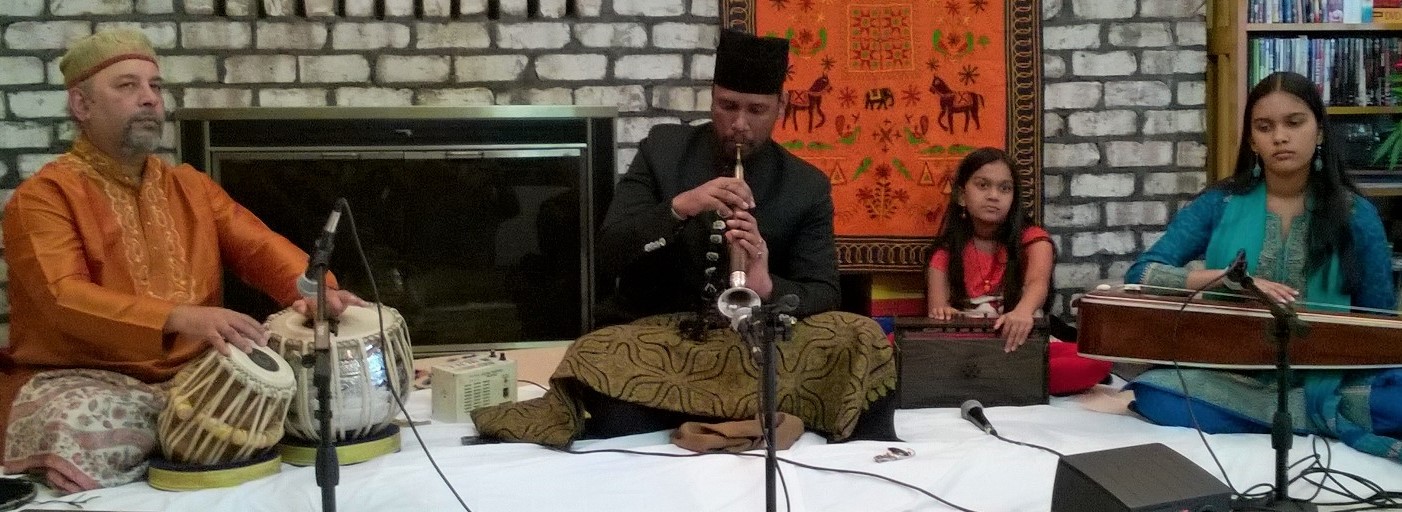 Pt. Samir Chatterjee, widely known for performing with eminent artists and as a soul-capturing soloist, accompanied UT Khan on the Tabla. I have been listening to Tabla performances for many years, but Pt Chatterjee on the Tabla in the recital made me completely fall in love with the instrument. His encouraging support to the young Khan enhanced the overall ambience of the evening.
Pt. Samir Chatterjee, widely known for performing with eminent artists and as a soul-capturing soloist, accompanied UT Khan on the Tabla. I have been listening to Tabla performances for many years, but Pt Chatterjee on the Tabla in the recital made me completely fall in love with the instrument. His encouraging support to the young Khan enhanced the overall ambience of the evening.
The concert started with pure Indian classical ragas and ended with beautiful semi-classical and folk pieces. Towards the end, Chatterjee briefly gave a background of Indian classical music, how the shehnai is made, and how challenging it is to play the wind instrument solo for three continuous hours.
The shehnai recital was special because this was a house concert in Irwin in music connoisseur Samar Saha’s aesthetically decorated living room. The audience got immersed in a pleasant journey in ragas and laya for three hours in the intimacy of the house-concert. The proximity of the stage gave the artistes an instant and intimate rapport with the audience.
Before the recital, in a good-natured way, Pt. Chatterjee looked around and spontaneously picked two young girls, Sohini Ghosh and Ahiri Ghosh, from the audience, and “volunteered†them to provided shruti support, which they obliged for all three hours of the recital.
I heard the two veteran artistes doing things I had never heard before, surprising me every time a new piece started. This gave me a rare opportunity to talk to them later. For me as a music producer, a music learner and a passionate music lover, this was God-sent. The evening ended with a delightful dinner and desserts making it a splendid event.  ♣
Shyamaa: Tagore Portrayal of Passion Ending in Tragedy
Posted by admin in July 2017, Past issues on July 21, 2017
By Siba Ray, Murrysville, PA Â Â Â Â Â Â Â siba1ray@gmail.com
On April 22 and April 23, the Nandini Mandal’s Nandanik Dance Troupe presented Rabidranath Tagore’s dance drama SHYAMAA. The Kelly Strayhorn Auditorium in Pittsburgh was the venue.
The story revolves around Shyamaa (Nandini Mandal), the court dancer, instantly falling in love with a handsome merchant Bojrosen (the talented dancer Hari Nair from Toronto) from a neighboring country, the moment she sees him. Many men of substance in the kingdom amorously desire the gorgeous Shyamaa. Among them is Uttiyo, a young man in the neighborhood, willing to do anything to please the dancer to draw her attention, even though he has never met her.
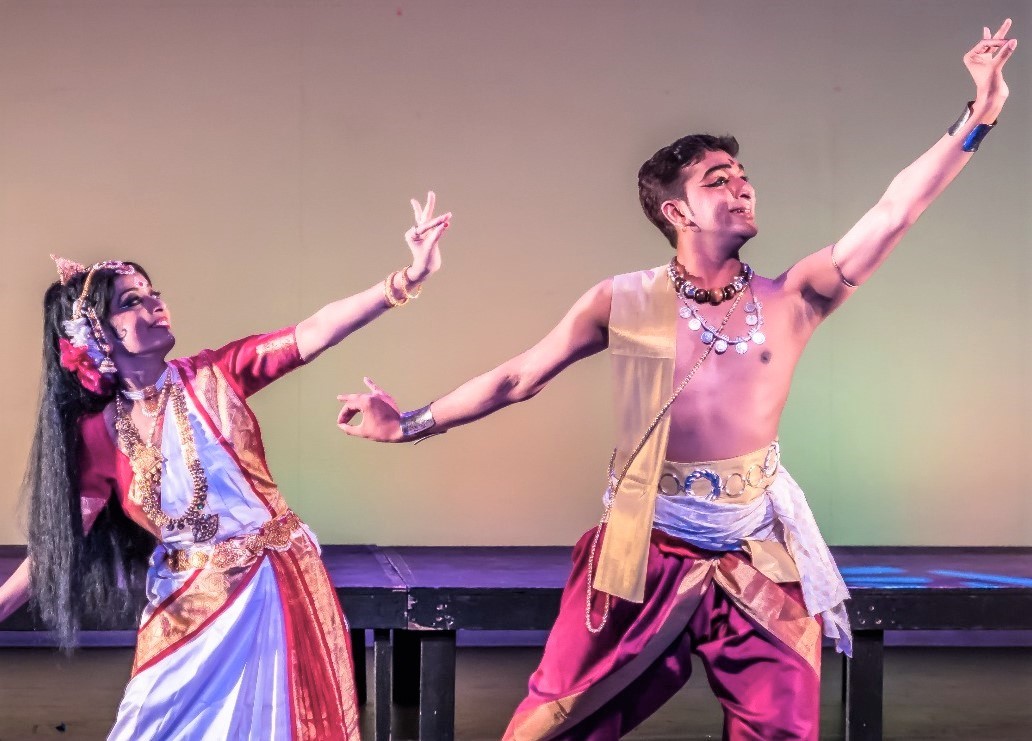
Nandini Mandal and Hari Nayar as Shyaama and Bojrosen
The drama starts with Bojrosen acquiring Indramonir Haar, a priceless necklace from Suborno Dwip (literally Golden Island). Bajrosen wants to gift the necklace to the bride of his dreams.
Meanwhile, there is a theft of jewels from the palace and the queen wants them back. The royal guard, Kotal (played by Kumudini Venkata on Saturday and Paushaly Sau on Sunday) and his men catch Bojrasen. They want the necklace, which Bajrosen refuses to part with. Chased by the royal guards, Bajrosen runs for his life along a river, when he comes across Shyamaa and her friends.
Shyamaa’s heart sets on Bojrosen the very moment she sees him. The palace guards arrest Bojrosen. Foisting a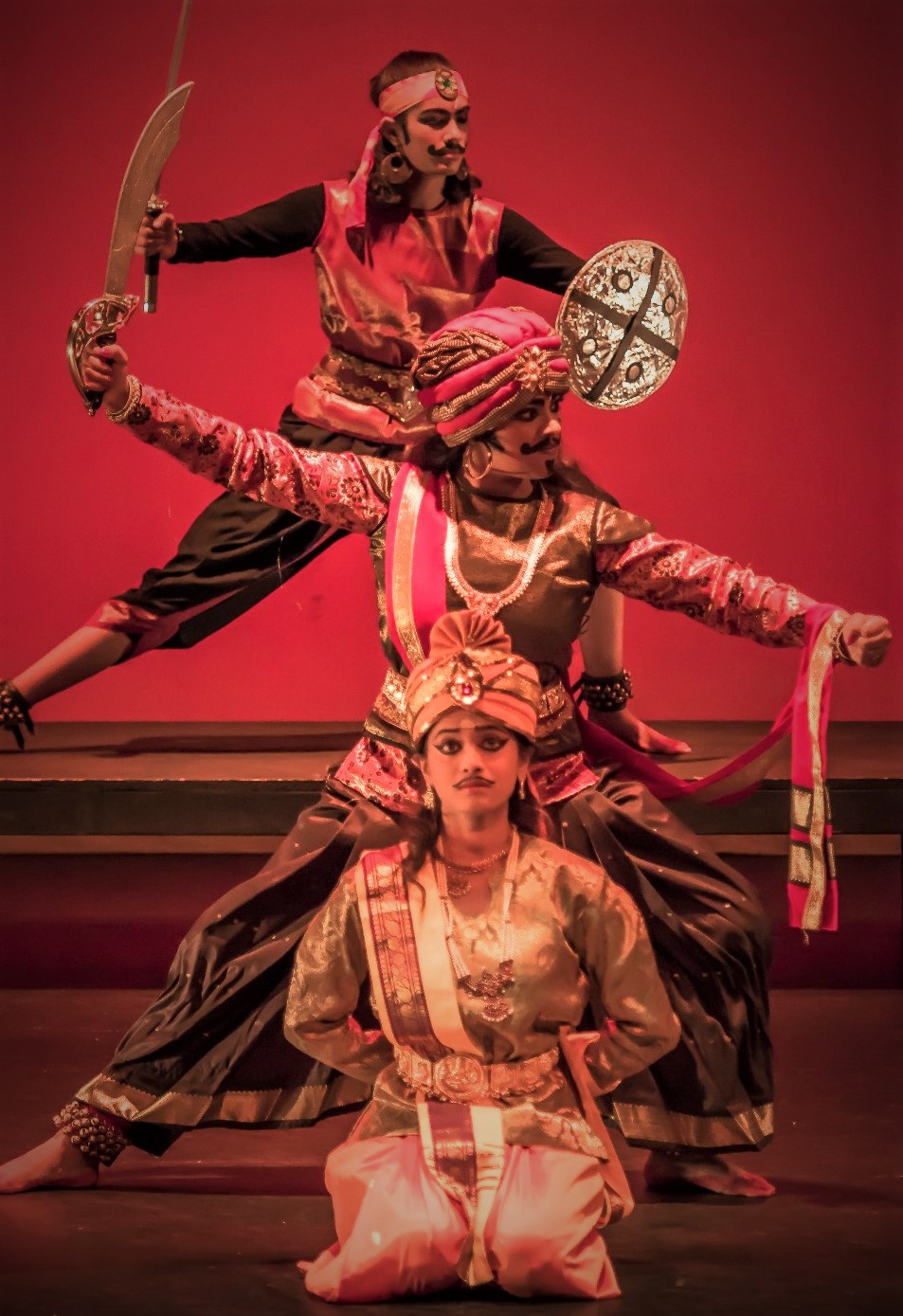 false case against him for possessing the invaluable necklace, they plan to execute him.
false case against him for possessing the invaluable necklace, they plan to execute him.
In her desperate attempt to save Bojrosen, Shyamaa lets her admirer, the young Uttiyo (played by Roosa Mandal), take the blame for the theft. Uttiyo is put to death.
Shyamaa and Bojrasen leave the country, with the merchant oblivious to how he was saved from imminent death. Love blooms between the two, but Bojrosen is inquisitive about how Shyamaa managed to save him from the clutches of execution. When he keeps on asking her how she secured his release, Shyamaa finally tells Bojrosen what she did because of her love for him, and the sacrifice of Uttiyo. Bojrosen is filled with guilt for Uttiyo’s death, and is disillusioned. He rejects Shyamaa’s love.
Having lost Bojrosen’s love, Shyamaa too is disenchanted with life, having been the cause of Uttiyo’s death, Rejected by Bojrosen, she too decides to leave. Bojrosen is left to live in remorse, deprived of love, happiness and peace.
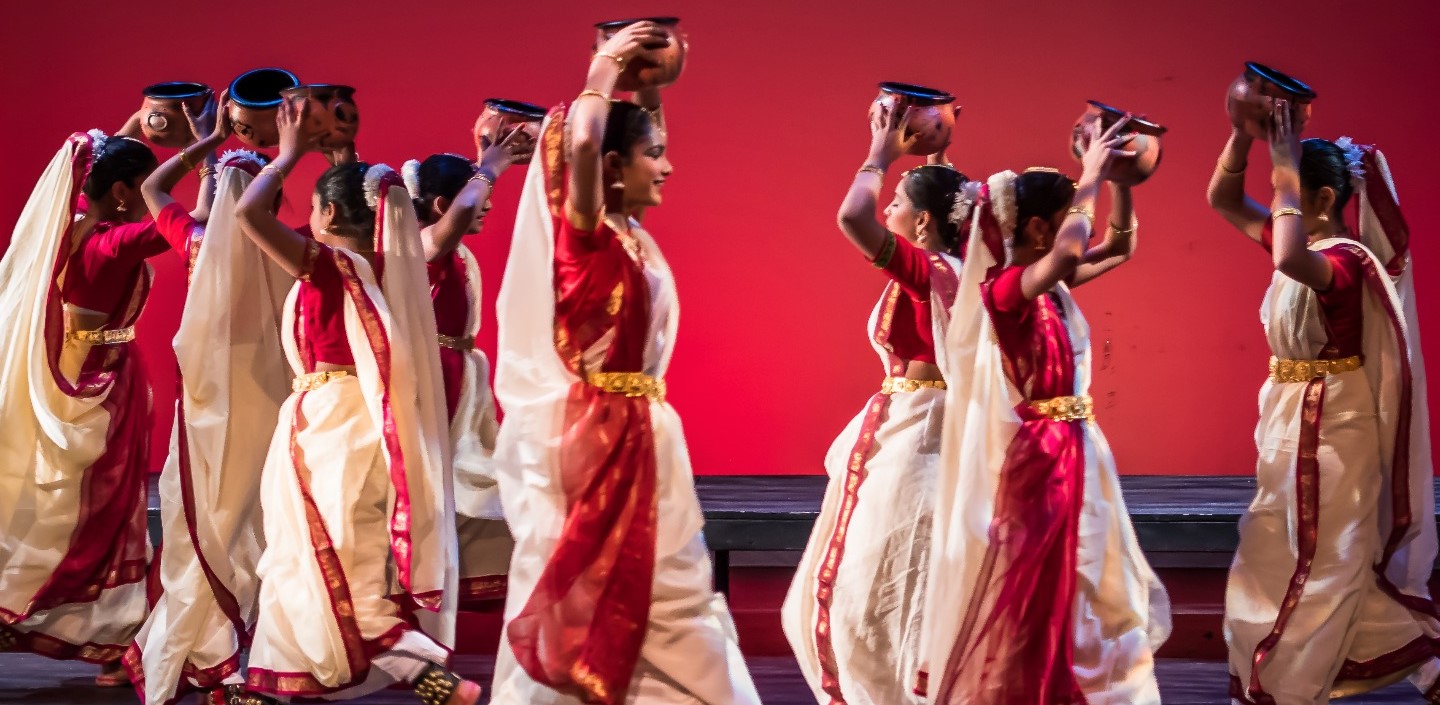
Behind the straight story of great tragedy, the story is a metaphor for life itself: the queen and the royal guard Kotal are unhappy not getting what they want, with Uttiyo even dying for Shyamaa. And Shyamaa and Bojrosen, the main characters in the story, also end up very unhappy after getting what they want.
Singers are critical for any dance drama. For Shymaa, the foremost exponent of Rabindra Sangeet, Pramita Mullick, from Calcutta, trained in Shanti Niketan, was the female singer, with Agnivo Bandopadhhay of Rabindra Bharati University as her male counterpart. Their well-modulated singing (in audio recordings) of Tagore’s Bengali verses elevated the quality of the dance drama.
 The main dancers all performed very well, among them Nandini Mandal, Hari Nair, Roosa Mandal as well as Kumudini Vankat and Paushaly Sau. Also, the large number of Nandini’s students — as flower girls and the sakhis, palace guards and others — showed great energy and passion in their roles. Hari Nair, as Bojrosen, nicely brought out the pangs in his heart depicting the sense of guilt for the death of Uttiyo and his inability to forgive Shyamaa for Uttiyo’s death.
The main dancers all performed very well, among them Nandini Mandal, Hari Nair, Roosa Mandal as well as Kumudini Vankat and Paushaly Sau. Also, the large number of Nandini’s students — as flower girls and the sakhis, palace guards and others — showed great energy and passion in their roles. Hari Nair, as Bojrosen, nicely brought out the pangs in his heart depicting the sense of guilt for the death of Uttiyo and his inability to forgive Shyamaa for Uttiyo’s death.
It was an enjoyable program. That over 400-plus people, many of them from the American mainstream, bought tickets for the program is a testimony to Nandini’s reach in the larger Pittsburgh community. Not many Indian dance programs in this town can make this claim.n
On Frenemies and Frenemity
Posted by admin in July 2017, Past issues on July 21, 2017
By Kollengode S Venkataraman      thepatrika@aol.com
Recently I came across a syrupy multi-serial-forwarded e-mail from India, this time on Friends and Friendship. The oozing syrup in the e-mail was too much for me. That triggered me to explore a paradoxical relationship everybody recognizes and nobody can escape from. This unnamed complex relationship, present in all cultures, now has a portmanteau word in English for those in this relationship – frenemies. The actual definition of frenemy depends on the dictionary you go to. Here are the examples:
- Merriam Webster: one who pretends to be a friend but is actually an enemy.
- Google.com:Â a person with whom one is friendly despite a fundamental dislike or rivalry.
- Wikipedia: “Frenemy†is an oxymoron and a portmanteau of “friend†and “enemy†that can refer to either an enemy pretending to be a friend or someone who really is a friend but also a rival.
- Dictionary.com:Â Informal; a person or group that is friendly toward another because the relationship brings benefits, but harbors feelings of resentment or rivalry.
From the nuanced differences in these definitions, it appears, the meaning of the term is still evolving. There lies the problem: no matter in what sense you use it, readers can internalize it in different ways.
From frenemy we can also coin an abstract noun frenemity, like enmity. Frenemity is known only among Homo sapiens, both the male and female species. The male species have this when they are in the same competing business as among news bureau chiefs of NBC, CBS, and ABC. Frenemity exists among doctors or lawyers in the same specialty practicing in the same town, or between editors of the NYTimes, WaPo and WSJ. In sports among QBs of football teams of comparable ranking. It is common among musicians, writers, dancers, actors everywhere, and among politicians vying for the same office. When two people in the same profession are unevenly matched, the one perched on the perceived higher level often has condescension toward the other. Often, the other guy/gal perceives the condescension. Those perceiving themselves to be below reciprocate with envy that can contextually morph into hatred. This one-way relationship is not frenemity. For frenemity, these love-hate feelings have to be mutual among equals.
Even though frenemity is gender-neutral, people watchers arguably believe frenemity is more prevalent among women.
How do you identify your frenemies among those with whom you interact socially? You can start with the points below. You can add your own to embellish the list.
Frenemies love you sometime and hate you some other time. But it’s not always this simple — they can love and hate you at the same time. It can be more complex: when you love them, they hate you; or vice versa.
When two frenemies love each other at the same time, it is all honey. When they hate each other simultaneously, it is all vinegar. Worse still, it can be caustic lye.
If the spouses of frenemies are normal friends, this can lead to awkward moments between the spouses. If they are not careful, frenemies will drag their spouses into their orbit. If these gullible spouses take sides, eventually they too end up as frenemies.
Frenemies, whether they love or hate, are always in each other’s thoughts; they constantly try to read each other’s minds, and try to stay one step ahead of the other in the social game they play. When they misread the other, it can lead to awkward interactions between frenemies. When these interactions happen in public, they are hilarious to onlookers. This is what nourishes gossips.
Frenemies care for you, for sure;Â but your frenemies also can be gleeful in your misery, particularly when they are in the hate-you mode.
Your frenemies are not from your family, thank God. If they are, they are your relatives, your cousins, your brothers-in-law or sisters-in-law. For Indians, they are your sambhandhis, particularly when they belong to the same caste, or the same socio-cultural group in a different Indian language (as when a Tamil marries a Bengali/Gujarati/Punjabi/Kannada/Telugu, and in its varied permutations and combinations). The caste identities add another toxic dimension. Or when they are your oarpadis or oar-agatti (Tamil), oori-gatti (Kannada) or jethanis (Hindi), or todi-kodalu (Telugu).
Though frenemies are not your blood relatives or relatives by marriage, they can be more lethal.
In interacting with frenemies, women appear to be more sophisticated than men in navigating the turbulent, turbid frenemity waters. Â You realize your frenemies have long memories, because you have a long memory.
Frenemies are ready to share your pains; Painfully for you, they share your pains with others who know you well, more so when they are in the Hate-You mode.
Whether you hate your frenemies or they hate you, you learn to live with them, because you cannot live without them either. As you read through this short piece, if the images of your own frenemies, or the images of your friends who are mutual frenemies flash through your mind, don’t blame me.  ♣  Â
Today’s Rebellion is Tomorrow’s Orthodoxy
Posted by admin in July 2017, Past issues on July 21, 2017
By K S Venkataraman     thepatrika@aol.com
It is one of the paradoxical twists in all reform movements all over the world — whether religious, social, political — that the rebels rising against the orthodoxy in their times eventually end up as a sect by themselves, or a subset within the system. They create their own traditions, and after a few generations, are constrained by their own orthodoxy.
Gautama Siddhartha, before he became the Buddha (or the Awakened One) for his followers, was a social critique and rebel in his time.  He defied many conventional norms of this time in matters of social order and faith.  A few centuries after the Buddha’s death, his followers split into the Teravada and the Mahayana. They further split into the Vaibhashika, Sautrantika, Yogachara, and Madhyamika schools, each having its own traditions and observances, with each buried in their own definitions on Buddhist practices and doctrinaire differences.  Many of these schools eventually fizzled out in India.
The Sri Vaishnavas of Tamil Nadu brought about rebellious reforms in the 11th century. Several decades after their founder Ramanuja’s death, they morphed into their own inviolable orthodoxy and broke into two groups — the Northern and the Southern sects (Vada Kalai and Then Kalai in Tamil) — with doctrinal differences, with each sect ending up having its share of temple properties and assets. They have taken their fights — some of  them may appear trivial to outsiders, for that mater, even to many insiders — all the way to the Indian Supreme Court.
The Veerashaivas, after rebelling against the caste system in the 12th century, are today a caste by themselves. The Sikhs too, who defied the caste system in 15th century to become a separate religion, internalized the caste system de facto.
Jesus of Nazareth was a social and economic rebel in his time.  After his death on the cross, his followers venerated him as Christ, meaning Messiah or the Anointed One. And calling themselves Christians (or the followers of the Messiah), the religious leaders of the faith, throughout history in later centuries  developed their own orthodoxy on many social, political and cultural matters –  Even on matters related to science such as whether the earth or the sun was at the center of the universe. The Vatican’s position was that earth was the center of the universe since Man was the best creation of their God, Yahweh in Hebrew.  On theological grounds and dogma, the church declared that earth was at the center (geocentric theory). The condemned Galileo who correctly argued that the sun was the center of the solar system.   In the following centuries, Vatican also took its stand against anesthesia, blood transfusion, contraceptives, organ transplants, and stem cell research, only to be overridden by common sense.
Eventually Christianity too broke into many groups: from the Roman Catholics, the Eastern Orthodox sects (Russian, Syrian, and Greek), Lutherans, Episcopalians, Presbyterians, Anglicans, Anabaptists, Calvinists, Methodists, Baptists, Fundamentalists, Charismatics, Quakers, Mennonites… … These divisions were based on political, social, and/or doctrinaire differences.
In India, the atheistic Communist movement offers another fascinating model. India’s Communist Party was formed to fight feudalism, inspired by the 1917 Russian Bolshevik revolution in the Czarist Russia. In response to the souring relationship between Soviet and Chinese Communists in the 1960s, Indian Communists split into CPI (loyal to Russia) and CPM (Marxist), loyal to China.
Soon the atheistic CPM, like a religion, splintered into countless groups — Naxalites (Charu Majumdar), Naxalites (Pulla Reddy), CPI (Marxist-Leninist), CPI (Maoists), Revolutionary CPI… …  See the long list of Communist Gotras (clans) here: www.tinyurl.com\Communist-Gotras. With their patron saints the Soviet Union now dead for nearly 3 decades, and China abandoning its socialist ideologies and becoming capitalistic, Communists in India are drifting away and gasping today to be relevant in politics.
Religious, social, political, and economic reform movements are like hurricanes, starting in nondescript spots in oceans with nobody recognizing them. Moving through warm ocean waters, they become large masses of swirling clouds with immense energy. They make landfall with great force causing enormous damage, and move inland, only to lose their strength and dissipate into smaller clouds causing only drizzles. After some time, the next hurricane arrives.   ♣
Veerashaivas: 12th Century Rebels Against Religious Orthodoxy in India
Posted by admin in July 2017, Past issues on July 21, 2017
By Kollengode S Venkataraman     thepatrika@aol.com
V.S.Naipaul, the celebrated writer of Indian ancestry from the Caribbean, wrote a harshly critical book on India in 1964: India: An Area of Darkness. Then, in 1977 he muted his critique by writing another book, India: A Wounded Civilization. His understanding of India culminated finally in India: Million Mutinies Now, the book he wrote in 1990 at the end of his own long, inward journey. Here he portrays ordinary Indians he interacts with struggling against great odds to change the stifling systems. The land of darkness morphed into a mutinous land.
No wonder many anglicized Indians think India was static and resistant to change till Turkic, Afghani, and Mongol marauders brought Islam in the 10th century and the European colonizing occupiers brought Christianity to India in the 16th century. For them, real reforms in India started with the europeanized, persianized Raja Ram Mohan Roy (early 19th century.)
In reality, though, since Vedic times, India always had a native intellectual tradition of people campaigning for change whenever society became ossified or exploitative. The teachers of the Upanishads, Jain Teertankaras, Gautama Buddha, Sankara, and Ramanuja are great examples, if you consider the social condition of their times. Such rebellions are in line with the Hindu idea of the need for periodic reforms: “I make myself appear again and again to restore Dharma whenever Dharma decays and corruption becomes widespread.†Rebellions are built into the Hindu ethos.
In this tradition of rebellion come the 12th century Veerashaivas in Southern India, against the Vedic Brahmin orthodoxy. The movement got its impetus through the works of Basavanna, Allama Prabhu, and Mahadevi Akka. Anna (elder brother), Akka (elder sister) and Prabhu (gentleman) are respectful appendages to their names. Some scholars believe Jedara Dasimayya (10th century) was a forerunner in this Movement.
Basava, Allama and others used to meet at the Anubhava Mantapa (Pavilion of Experience) in Kudala Sangama, a temple town, now a pilgrimage place in Bagalkote district in Karnataka State. They debated on Bhakti (devotion), Jnana (Knowledge), and Vairagya (detachment) for bringing egalitarian changes in society.
The Veerashaiva Movement campaigned against the ossified caste division of its time. Even though millennia ago, this division had a rationale for organizing society in terms of skills, it got stratified as “high†and “low†castes in later centuries. By the 10th century India, the system was further fossilized, based exclusively on birth.
Veerashaivas rejected the authority of the Vedas, the need for an intermediary priest and empty rituals. It was a radical idea, like today Jews, Christians, and Muslims rejecting the need for rabbis, priests/pastors, and maulvis to get through life’s transitions. The Veerashaiva idea of Godhead is Shiva, the Supreme One, who causes the entire gamut of creation, preservation, and dissolution, going in endless cycles.
Even as they rebelled against the ossified Vedic system of their time, Veerashaivas accepted its cultural bearings such as pursuit of knowledge, logical analysis, bhakti, jnana (wisdom); discipline, contemplation and liberation; karma and rebirths; and the need for Gurus in Man’s spiritual quest. The teachings of the Veerashaivas are in Vachanas, literally “Sayings,†some of which are iconoclastic. Kabir Das, Ravi Das, and Bulleh Shah, also known for their acerbic iconoclastic verses, came many centuries later, in the 15th, 16th, and 18th centuries, respectively.
In one of the vachanas, Basavanna, using vivid imagery, sarcastically reproves the Vedic Brahmin priest. In this, the priest, who worships fire as divine, has no qualms cursing the fire when it suits him. Basava himself being a Brahmin only shows he was, indeed, a true rebel. Here is the vachana, first in Kannada:

The contents of the Vachana in English:
The pandit in his house worships fire as deity, offering cooked rice  as oblations to the fire; Â
The fire goes wild with the flames burning down the house.
They dump the gutter water and dirt from the street to douse the fire, and scream for help from all around.
Forgetting their worship, they curse the fire.
O, Koodala Sangama Deva (The Lord of the Meeting Rivers)!
Veeerasaivas are scattered throughout the Peninsular India in Maharashtra, Andhra/Telangana, Karnataka, Tamil Nadu, and Kerala. In today’s Karnataka, the contribution of Veerashaivas in primary, secondary and tertiary education (arts, science, engineering, law and medicine) is substantial. Their impact in Karnataka’s public life — arts, literature, politics, and administration — is important too. Their presence and impact in other parts of Southern India are also noteworthy.
It is ironic that Veerashaivas, who fought so passionately against the caste system, ended up being a dominant caste in Karnataka. More on this here.  ♣
An Endemic Feature in Indian Music Programs
Posted by admin in July 2017, Past issues on July 21, 2017
By Kollengode S Venkataraman      thepatrika@aol.com
For-profit entertainment programs based on Indian film music are popular, with tickets sold in the thousands in big cities. In these events the emcees go to great lengths to introduce the songs with details and filmi trivia — the year and films in which they appeared, the playback singers, the music directors, the actors who lip-synched for the song… even vividly describing how the song was picturized. One thing they often miss is crediting the lyricists (kavis) who penned these memorable songs.
This was the case in the Sahana-2017 event also for very many songs. In the review two years ago on Sahana’s 2015 fundraiser, the Patrika wrote this (Full review here: www.tinyurl.com/2015-Sahana-ReVu):
“Indian film songs describe different moods — joy, pathos, irreverence, sarcasm, humor, irony, paradoxes, and the dilemmas of life — often conveying great insights into life’s complexities. Some of the really good ones are as good as paid sessions with psychologists. So, lyrics are the heart, soul, spirit, and the very life of [good] film songs… … [Hence] leaving out the names of the lyricists who penned the masterpieces … … while mentioning the names of the films, music directors, and the singers who simply lend their voices… is inelegant… Sahana can correct this quite easily in their future programs.â€
Using songs without giving credit to the lyricists is discourteous and unfair to the lesser-known poets. This topic is worthy of a stand-alone article.
We sent the above to Sahana’s Mr. Girish Godbole. His response is given below. Readers can make their own judgment.
“Mr. Venkataraman’s opinion is right that a lyricist (“kaviâ€) is a key contributor to a song. However, in criticizing the Sahana-2017 event for not mentioning the lyricist of every song, he seems to have missed the point that it was a live entertainment show which was “emceed,â€Â not “announced.†An emcee’s role is to make an entertaining introduction to the next song while following the theme of the show and linking the various items like a beautiful seamless garland. This is exactly what the emcees of Sahana 2017 Bollywood Show did. The advertised theme of the show was “Shankar Jaikishan to Shankar Mahadevan†— clearly a theme focused on music composers. The emcee’s narrative mostly talked about the music composers, their styles, their sources of inspiration, etc. In a handful of cases, where it was particularly relevant, the emcees mentioned the lyricist’s name, and in one case even the original lyricist’s name in the original Punjabi song. The rest of the emceeing was appropriately focused on making it funny, entertaining and interesting in line with the theme and spirit of the evening.†   ♣
Pittsburgh Sahana’s Successful Fundraiser
Posted by admin in July 2017, Past issues on July 21, 2017
By Subash Ahuja      subash.ahuja@gmail.com
It was prime time for Pittsburgh SAHANA when it presented an evening of enchanting Bollywood Music in a well-attended program on May 20, 2017 at the Marshall Middle School in Wexford. The fourteen-member band with its live orchestra took young and old alike down memory lane from Shankar-Jaikishan to Shankar Mahadevan. Many in the excited crowd were on their feet dancing in the aisles and wherever.
Girish Godbole, an entrepreneur in technology companies, and Nakul Ranade, a marketeer, emceed the program, humoring the audience with Bollywood trivia. The vocalists — Akshay Hari, a two-time Sa-Re-Ga-Ma-Pa finalist, and Vaibhav Karandikar, Asha Rajawat, Gayathri Shriram and Nakul Ranade — although referred to amateurs, were truly star quality.

Sahana group taking their final bow at the end of the program.
While pursuing their love for music, they have been giving concerts since 2009, successfully raising funds for various charities. They raised around $25,000 in this concert for the Association for India’s Development (AID and www.aidindia.org), a volunteer organization founded in 1991 and with 36 chapters in U.S. cities. AID volunteers before the program talked about the various women’s empowerment projects they operate in India. Over the years, SAHANA has raised over $110,000 benefitting various charities in India and the U.S.
Originally formed ten years ago as a loose group of music enthusiasts by Shriram Murthy, an engineer, and his wife Gayathri, an accountant, when they first moved to Pittsburgh, Pittsburgh SAHANA has grown into a full-fledged band with a mission. Arunkumar Sanjeevi and Niveditha Mohan, both physicians, have opened their house to the group for their meetings and music practice.
Remarkably, the youth members of the group — Vikaas and Samyukta Arunkumar, and Keerthana Shriram — inspired by Pittsburgh SAHANA and their parents, have taken lessons in piano, guitar, drums, keyboard, saxophone and trumpet in their high schools. Now they are part of the group. Ganesh Narayanan, deft on keyboard and drum pads, and Chockiah Suresh, facile on his guitar, are the remaining valuable members in the ensemble. The SAHANA musicians plan to continue making a difference in people’s lives through entertainment while having fun with their passionate interest in music.   ♣
Desi Transitions: Insider Trader Rajat Gupta Blames the Aggressive Prosecutor His Jail Term
Posted by admin in July 2017, Past issues on July 21, 2017
By Kollengode S Venkataraman
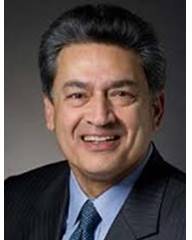
Rajat Gupta (picture on the left), an alumnus of IIT-Delhi (1971) and Harvard Business School MBA (1973), was the youngest and the first foreign-born managing director at McKinsey & Co. He was barely 45 when became the chief executive of McKensey. His background is the stereotypical Bengali Bhadralok — his father was a journalist and professor, and his mother taught in a Montessori school.
His parents died when he was in his teens. He was brilliant in his studies.
His meteoric career on Wall Street as a foreign-born Wall Street executive was a model for ambitious Indian business school graduates. He was a board member at Goldman Sachs, Proctor & Gamble and AMR (the holding company of American Airlines); and he was in many big-banner global philanthropies fighting AIDS, TB, malaria…
Gupta is also a convicted felon. In 2012 Gupta was given a 2-year prison term and a one-year supervised release, plus a $5 million fine for insider trading. The jury convicted him for colluding with billionaire Raj Rajaratnam, the hedge fund manager of Galleon Group, then one of the largest hedge funds. Gupta’s net worth at that time was around $100 million. Savor the irony that Gupta’s parents, as reported in the Economic Times in India, were communists.
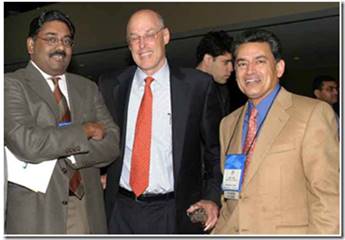
In his first interview after coming out of prison, Gupta talked, not to any US print media in New York such as the Wall Street Journal, New York Times, where he made his mark in his career and his millions, but to Vikas Dhoot of The Hindu. The interview was published in March 2017 under the title “Had a Good Time in Prison.” See here: www.tinyurl.com/RajatGupta-Good-Time-in-Prison.    Â

The case against him was for “trading privileged information when he was a director at Goldman Sachs and many other big corporations” with billionaire Raj Rajaratnam, manager of the hedge fund Galleon Group. Rajaratnam is serving his 10-year jail term in the same case. Gupta conceded to Dhoot that he wouldn’t have gone to jail for sharing information if he was more careful about whom he trusted: “If I were to fault myself, I would say I trust too many people.” After all, he was sitting on many corporate boards with access to policy-level privileged information of the business world having the potential to make huge profits, if you know such privileged information ahead of others.
After his prison release, he went to India, where he was accorded a homecoming welcome by his friends and associates in New Delhi, who are among the richest and most famous. See here: www.tinyurl.com/Gupta-HomeComing-AfterJail.
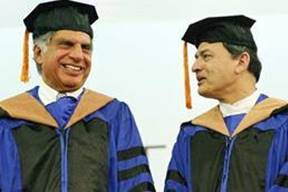
“We welcome Rajat wholeheartedly. I don’t know of another PIO [person of Indian origin] who has done more for India. Fairly or otherwise, he has served his term. We have to move on in life. Forgive, forget and let things go,†said Mr Analjit Singh, DEO of Max Indian, to the Economic Times.
Bharti Airtel chairman Sunil Mittal waxed in exuberance, “He [Gupta] has served time for an offence which he continues to challenge in courts. I am sure Rajat will find a renewed purpose to use his skills. He drew strength from Bhagwad Gita through his difficult time which, I hope, will shape his future.â€Â Mittal also said Gupta brought to bear his position as the head of a global consultancy to focus on issues like public health and education in India.
After being released early from prison in late 2015, Gupta was sent to complete the sentence confined to his home. In a letter to his buddies on January 1, 2016, Gupta shared his prison experiences. The letter was recently made public. Here are excerpts from his letter:
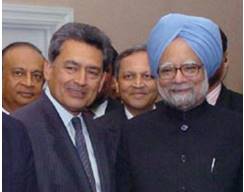
“[On this] New Year’s Day… I could not but reflect on my time in prison. A difficult chapter of my life [comes] to a close. The last eighteen months have taught me a lot and I will mostly remember it as a joyful time, full of camaraderie, laughter… … I have forged some deep friendships that I will keep for the rest of my life. I learnt many new skills and was able to teach fellow inmates a few too.
“Even though the [prison] regime tries hard to ensure that the prison does not become a community, most of us look after each other and help whenever we can.
“In the last 18 months, I lived in three different facilities, nine months in a low security prison, two months in solitary confinement and seven months at the main prison.
“As a result, there was a great variety of living situations, experiences and people I encountered. Every place has its own peculiarities and culture. There were a few experiences that I will never forget, such as the first gay couple who wanted to get married despite the reticence of the regime in the prison… … It turned out that one of the men was not gay at all. It was a ruse employed in order to get transferred to some other facility.
“Well, in addition to reading, meditating, and working on writing a new book, I learnt many new skills including some new card games … I also took up chess again, after 50 years… … I even learnt some new hood [Black slang] language like, ‘Let me see that’ — which means give that to me. ‘Riding together’ — which means eating and cooking together.
“Overall, I am glad to be leaving here, but I had a good time. In a very strange way, I will miss the place…
“Necessity is the Mother of Invention. It’s so true in prison. The exquisite dishes that inmates can cook using only the microwave… we only had access to the microwave oven. I enjoyed a variety of cuisines, Mexican, French, Asian, Spanish, Puerto Rican, Chinese, Italian and of course, usual American foods.
“I had a world class trainer who pushed me into shape doing squats, sit-ups, push-ups and the like. I have had expensive trainers outside but no one as good as this guy who cost $5 an hour.
“As they say, life is a series of experiences. None is inherently good or bad. It is what you make of it. This experience has been good for another very important reason. The love I received from each one of you (my friends) during this difficult time and you should know it means a lot to me. Let me close by wishing you a very Happy New Year.”
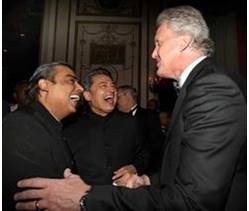
In Rajat Gupta’s letter to his friends after leaving jail there is no remorse — because that would imply accepting guilt. The tone of the letter is as if he went to jail as a Satyagrahi (Seeker of Truth) like Mohandas Karamchand Gandhi or for Civil Disobedience a la Martin Luther King Jr. Gupta went to jail for nothing noble. He went to jail for greed, as an arthagrahi (seeker of wealth) by indulging in abuse of privileged information.
Fascinatingly, one sees in Gupta’s letter the ability of the human psyche to compartmentalize personal behavior into watertight chambers, even when the contents of the chambers are in blatant contradiction. This is similar to priests being caught in pedophilia while they preach public morality from their pulpits, or when our Congressmen take conservative stands displaying moral rectitude in speeches, when in their personal lives, their behavior is just the opposite. When we try to understand such inner workings of human mind, it is disconcerting.
In looking at Rajat Gupta, are we looking at ourselves? That is a scary thought. ♠ END

Cosmic Design — Shanthi Chandrashekar’s Paintings
Posted by admin in July 2017, Past issues on July 21, 2017
By Premlata Venkataraman      ThePatrika@aol.com
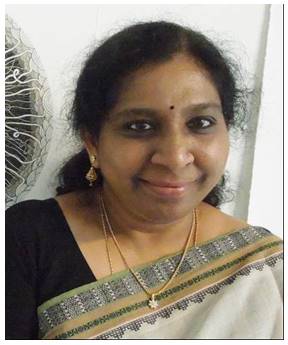 Shanthi Chandrashekar (photo on the left), an Indian-American visual artist living in Maryland, had her paintings titled “Cosmic Design,†inaugurated at the Lantern Studio in Downtown on June 2, and concluded on July 2. In the inaugural reception, I talked to Chandrashekar.
Shanthi Chandrashekar (photo on the left), an Indian-American visual artist living in Maryland, had her paintings titled “Cosmic Design,†inaugurated at the Lantern Studio in Downtown on June 2, and concluded on July 2. In the inaugural reception, I talked to Chandrashekar.
Explaining her art, Shanthi said, “Cosmic Design is an outcome of my fascination for the unknown, be it the journeys of the subatomic particles or the mapping of black holes. In my multimedia work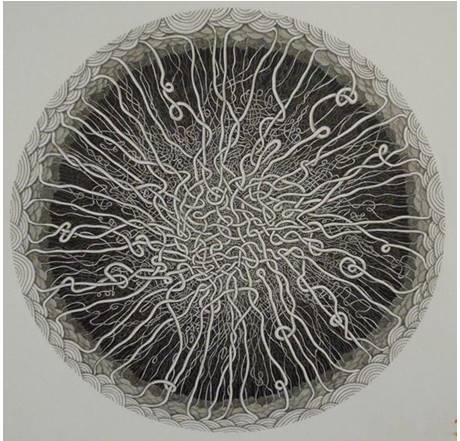 , I explore the scientific concepts with ideas ranging from the microcosm to the macrocosm, from quantum mechanics to relativity and from singularity to infinity, juxtaposing of science and art.â€
, I explore the scientific concepts with ideas ranging from the microcosm to the macrocosm, from quantum mechanics to relativity and from singularity to infinity, juxtaposing of science and art.â€
Shanthi graduated with a master’s degree in physics from Chennai, India. She grew up near Kalpakkam, near Chennai where nuclear physicists work, who inspired her. Her paintings capture the mysteries of the universe through patterns and symmetries with repetitive figures representing the universe in Hindu and Buddhist symbolism. Her paintings are mostly pen and ink. But she also has some in acrylic and some done on handmade paper.
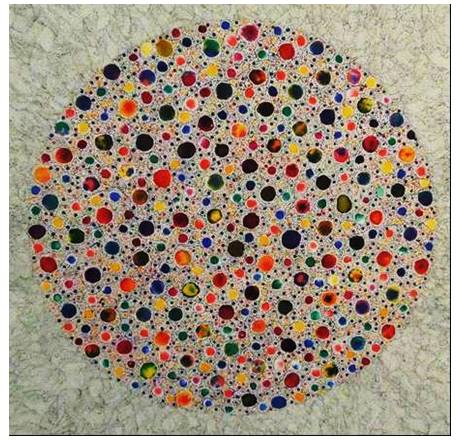 Her paintings immediately bought to mind fractal dimensions and the brightly colored kaleidoscopic glass images under high magnifications to the person accompanying me. He is a materials scientist. A few images reminded me of the transverse sections of in plants in botany.
Her paintings immediately bought to mind fractal dimensions and the brightly colored kaleidoscopic glass images under high magnifications to the person accompanying me. He is a materials scientist. A few images reminded me of the transverse sections of in plants in botany.
Shanthi says, “I try to find answers to the big questions in our lives, philosophy and religion through my paintings.â€
Definitely an interesting exhibit in town for the Indian community and for others as well struggling with these eternal questions.   ♣
Unsettling Early Days of Trump’s Presidency
Posted by admin in July 2017, Past issues on July 21, 2017
By Kollengode S Venkataraman       thepatrika@aol.com
People are incapable of rationally responding to frequent, erratic changes even in their personal lives — in their careers, health, marriages … — all occurring around the same time. They become numb and focus on how to get through the day. When these changes do not immediately affect them, people ignore them even when these changes have long-term consequences for them personally. That is what is happening since Donald Trump became the president. Ordinary folks — not people in the news business, politicians, partisan types or news junkies — simply have withdrawn, as if this is happening in some other country far away. But late-night comedy shows are having a field day with grains of hard truths underneath the supposedly humorous quips in these shows.
 Trump’s harshest critics are not only liberal writers of the New York Times and the Washington Post, but also traditional conservatives like the Wall Street Journal’s editors, David Brooks, Bill Kristol, and many others. GOP members of Congress are adrift, thinking about their own survival in next year’s mid-term elections. Only right-wing radio and TV talk shows are singing the paeans of praise for Trump.
Trump’s harshest critics are not only liberal writers of the New York Times and the Washington Post, but also traditional conservatives like the Wall Street Journal’s editors, David Brooks, Bill Kristol, and many others. GOP members of Congress are adrift, thinking about their own survival in next year’s mid-term elections. Only right-wing radio and TV talk shows are singing the paeans of praise for Trump.
With his erratic management style, Trump’s White House staff work under fear, insecurity, and embarrassment. These are the most loyal people willing to be the fall guys for their boss. When they try to shield their erratic boss — we understand this is in their job description — they contradict themselves often within the same day and become caricatures. Trump’s press secretary Sean Spicer is one example. His Secretaries of State and Defense are in the dark on key foreign policy decisions till they see them in the media.
With Trump’s obsession over not getting favorable news coverage, he runs his administration by nocturnal tweeting. His staff wake up each day wondering which bizarre comments of their boss they need to defend.
Nearing his six months in office, thousands of jobs in the Trump administration are vacant, many needing Senate approval, including ambassadorships, usually given as return favors to big donors in the election. Many offices of federal prosecutors are also vacant. People have withdrawn their nomination; many don’t even want to be considered for key appointments. These are normally jobs coveted by people driven by commitment, ideology, ambition and adrenalin.
When in Europe in May, Trump castigated publicly his NATO allies for not paying their share of bills, something many US presidents have done, but in closed-door meetings. Savor the irony. Trump, in running his business, was not a model for financial or professional probity. His businesses centered on gambling filed for bankruptcies several times.
After WW II, the victorious US formed the NATO military alliance, driven by its national self-interest, willingly footing the bill to achieve its two geostrategic objectives. The first was to contain the inevitable military power and political influence of the Soviet Union, its WW-II ally. Remember, Soviet Union too was a victor in WW-II after suffering the biggest loss* in the war. The second unstated objective was to prevent the re-emergence of Germany as a military power, and keep Germany on the its side. After all, Germany’s military growth culminated in the disastrous war*. The US achieved both with NATO. The alliance was against the Soviets; and the US kept Germany within NATO, with its largest military presence (outside the US) in Germany, nearly 50,000 troops.
Trump’s disastrous public performance in Brussels — targeted to satisfy his domestic audience — might have sowed the seeds for the re-emergence of Germany as a third military power in Europe having its own geostrategic interest that may not align with US interests. Listen to what Angela Merkel said in Berlin the day after Trump’s Brussels speech:
“The times in which we can fully count on others are somewhat over, as I have experienced in the past few days. And so, all I can say is that we Europeans must really take our destiny into our own hands… Of course we need to have friendly relations with the US and with the UK, and with other neighbors, including Russia… We have to fight for our future ourselves, for our destiny as Europeans. Where Germany can help, Germany will help, because Germany can only do well if Europe is doing well.â€
The Trump presidency hastens the US decline as the sole Super Power, which was already declining slowly. The US’s dependence on its military muscle rather than on diplomacy to retain its global influence has the opposite effect. The simultaneous rise of other global power centers and alliances are already challenging the dominance of the US.
* Note: 80 million deaths, totally. 26 million in Soviet Union alone, 8 million in Germany, 6 million in Poland, 2 million in India, 18 million in China, 3 million in Japan, and a minuscule 0.45 million in the UK and 0.41 in the US. Â Â ♣
